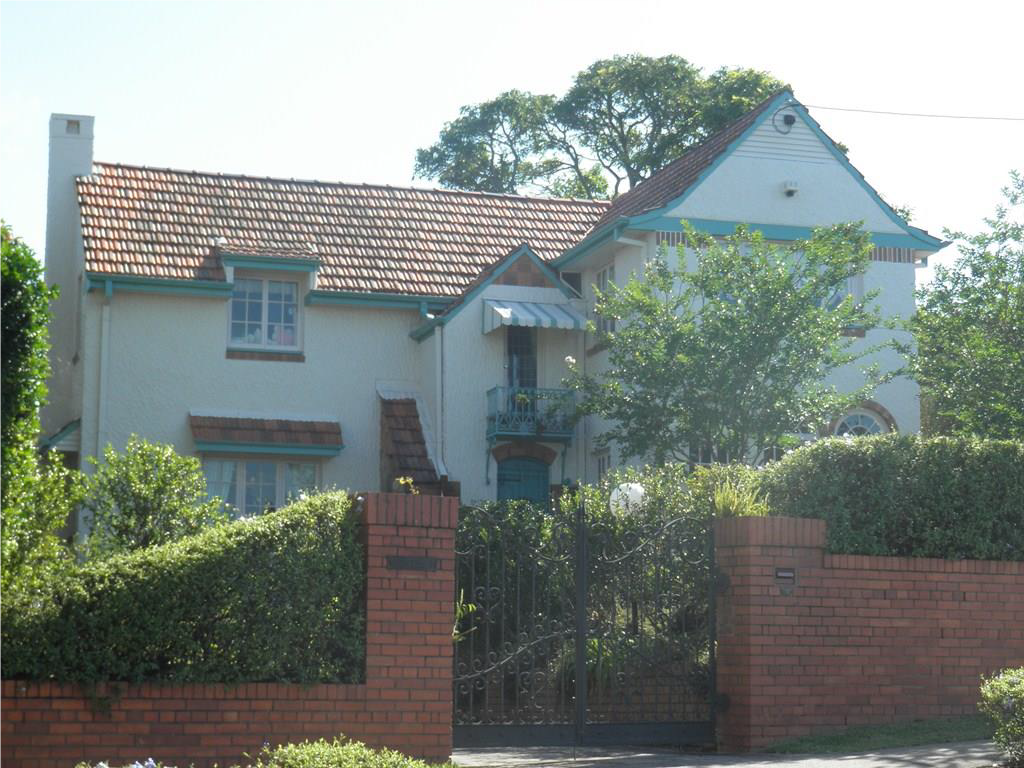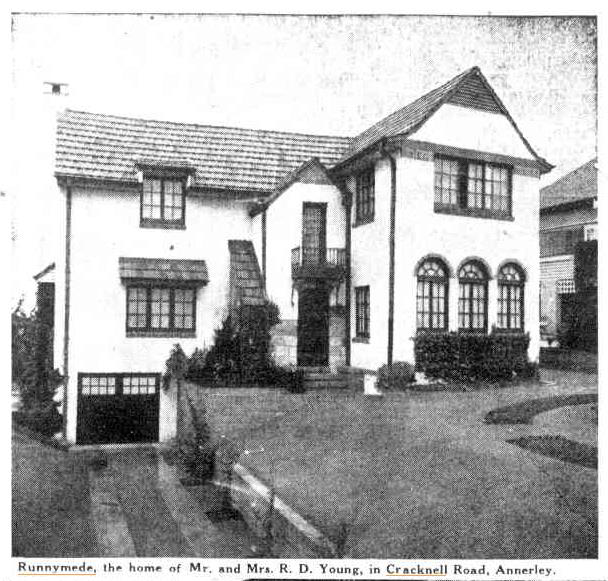Addresses
Type of place
House
Period
Interwar 1919-1939
Style
Arts and Crafts
Addresses
Type of place
House
Period
Interwar 1919-1939
Style
Arts and Crafts
This elegant, interwar home was built in 1934 for Robert David Young, a secretary, and his wife, Marie Florence Young. The architect for the house was Horace Driver.
Constructed from timber and brick with stuccoed exterior walls and a tiled roof, it was an expensive house for the time, costing over £1 400. The house and its interior were featured more than once in the newspapers of the period. At this time, Annerley was a fashionable suburb for the city’s well-to-do residents.
Lot plan
L2_RP183700
Key dates
Local Heritage Place Since —
Date of Citation —
People/associations
Horace George Driver (Architect)Criterion for listing
(A) Historical; (D) Representative; (E) AestheticInteractive mapping
Lot plan
L2_RP183700
Key dates
Local Heritage Place Since —
Date of Citation —
People/associations
Horace George Driver (Architect)Criterion for listing
(A) Historical; (D) Representative; (E) AestheticInteractive mapping
History
‘Runnymede’, built in 1934 for Robert David Young, is situated on the elevated southern side of Cracknell Road with views of the city. It was part of the Queenstown Estate which was developed for housing in the early twentieth century.
With the arrival of the tram along Ipswich Road to Cracknell Road in 1915, Annerley, like many other inner suburbs, experienced a residential building boom. Elevated sites that were easily accessible from the city by train were highly sought after and attracted affluent families that could afford stylish, well built homes - often architect designed. While the tramline provided a popular mode of transport, increasing car ownership meant that many new homes were designed to include a garage.
Many of the homes built during the interwar period at Annerley and other fashionable suburbs such as New Farm, Coorparoo and Ashgrove, featured new architectural styles and were constructed of masonry and tiles rather than the traditional materials of timber and corrugated iron. Popular styles included Spanish Mission, Mock Tudor and Californian Bungalow. Some homes amalgamated features from several styles, including Mediterranean and Arts and Crafts, resulting in eclectic interwar homes such as this one.
In 1933, two allotments in the estate (just over 40 perches) were acquired in the name of Marie Florence Young (nee Doolan), the wife of Robert David Young, whose occupation was given at the time as “secretary”, although earlier records indicate he was a wool classer. The Youngs applied to Council for the construction of a wooden and brick residence on the Cracknell Road site in January 1934. The builder for the Youngs’ residence was C.H. Schubert with whom Driver had an association until the 1960s. The estimated cost of the house, named ‘Runnymede,’ was £1,437, a considerable sum at the time when a timber house at Annerley cost around £400 to construct. In comparison, a brick and tile house designed by the architect, EP Trewern at Clayfield in 1934 cost the owner £1,100 to build. Horace Driver also designed the neighbouring house of Florence Young’s parents’ at 73 Cracknell Road and the home of Robert Young’s brother at 24 Jolly Street, Clayfield.
Horace Driver (1902-1982) was employed as a draftsman for the architectural firm of Hall and Prentice in the early 1920s. He also worked in San Francisco and Chicago before studying architecture at the Beaux Arts Institute in New York in 1930. Upon his return, he registered as an architect and set up his architectural practice at Auchenflower. Driver designed dozens of masonry homes in Brisbane during the interwar period, principally in the Ascot/Hamilton area and the inner Eastern suburbs such as Coorparoo and Holland Park. He designed three blocks of flats, including ‘Eden Court’ at Hillside Crescent, Hamilton and was responsible for many non-domestic buildings in Brisbane. These include St Stephen’s Anglican Church at Coorparoo (1958), St John’s Anglican Church at Enoggera (1962), the Sandgate Freemasons Home (1955-65) and several B.C.C. (later Woolworths) stores.
In 1940, ‘Runnymede’ was featured in an article in the Telegraph. The article described the house as “of two-story [sic] form in brick favouring the Georgian era which is notable for its simplicity and therefore its adaptability to the modern scheme of design”. Mention was made of the polished hardwood floors, “picturesque entrance detail with its balcony featuring some delicate wrought iron work” and the heavily beamed ceilings of the living and dining room. In 1941, the interior of ‘Runnymede’ was depicted again in the ‘Telegraph’ for the elegance of its dining room.
‘Runnymede’ has borrowed elements of various interwar styles: for example the stuccoed exterior and tiled roofs of the “warmer climate” styles of Mediterranean and Spanish Mission architecture. These styles were popularised by magazines such as Home Beautiful and had an air of glamour borrowed from Hollywood and the silver screen. The Mediterranean style (thought by some to be more refined than Spanish Mission architecture) was promoted by Sydney professor of architecture, Leslie Wilkinson, who recognised the similarities in lifestyle and climate of the Mediterranean countries and coastal Australia. In Brisbane, the Mediterranean style was interpreted by local architects, for example, EP Trewern, who designed ‘Oogarding’ at Bardon in 1940 and George Rae who designed ‘Greystaines’ – a three storey block of flats on Kingsford Smith Drive – in 1934. One feature of this style was the group of arched windows to the ground which can be seen in ‘Runnymede’s front façade.
The design of ‘Runnymede’ has also borrowed from the Old English and Mock Tudor styles and even the earlier Arts and Crafts architecture of England with its catslide roof, Juliet balcony, casement windows and prominent gabled roof. The result is an elegant and picturesque home which epitomised the desire of the well-to-do to display their social standing in a refined manner.
The house has had some extensions at the rear, including an addition to the patio.
The Youngs retained the property until 1967. In 1983, it was subdivided into two lots and the western portion sold, leaving ‘Runnymede’ on the current lot of 987 m².
Description
‘Runnymede’ is a two-storey, masonry home situated on the higher side of Cracknell Rd. It has a tiled gabled roof with a simple chimney and two additional gables above the front elevation. The house has rendered walls, a variety of window forms and a Juliet balcony. A driveway leads to a built in garage located below the ground floor on the eastern side of the house and the front boundary is marked with a solid face brick fence. Decorative wrought-iron gates were installed in the brick fence in 1997.
Statement of significance
Relevant assessment criteria
This is a place of local heritage significance and meets one or more of the local heritage criteria under the Heritage planning scheme policy of the Brisbane City Plan 2014. It is significant because:
Supporting images

Telegraph, 28 May 1940. (Elevation from Cracknell Rd)
References
-
Department of Natural Resources and Mines, Queensland Certificates of Title
-
BCC Building Register.18 Jan 1934., p 210.
-
BCC Detail Plan, no. 446.
-
Queensland Post Office Directories
-
Digitised newspapers and other records. http://trove.nla.gov.au/newspaper
-
Telegraph, 28 May 1940
-
Telegraph, 8 Feb 1941
-
Courier Mail, 19 Feb 1936, p 18
-
Heritage Victoria, Victorian Heritage Database details. Bruce Manor. file:///C:/Users/044627/Downloads/BRUCE%20MANOR_report_11-1-2016%20(1).pdf. Retrieved 11 Jan 2016.
-
Ancestry.com. Commonwealth Electoral Rolls. http://interactive.ancestrylibrary.com
-
McKellar's Map of Brisbane and Suburbs. Brisbane: Surveyor-General’s Office, 1895
-
Kennedy, Michael Owen. ‘Domestic Architecture in Queensland Between the Wars’, Master of the Built Environment (Building Conservation) thesis, University of New South Wales, 1989
-
Donald Watson and Judith McKay, Queensland Architects of the Nineteenth Century, South Brisbane: Queensland Museum, 1994
-
Andrew Gildea, Horace George Driver: Architect 1902-1982: Beaux-Arts to Our House. BA Arch. Thesis, U of Q. 1988.
-
A&B Journal. 11 Dec 1933, p 21.
Citation prepared by — Brisbane City Council (page revised September 2020)


